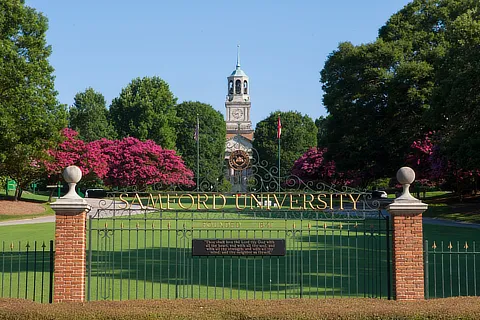
Samford University’s estimated annual economic impact on the state of Alabama is more than $453.3 million, according to a study released earlier this month. The university is also a significant driver of workforce development. The independent study was conducted by Samuel Addy and Ahmad Ijaz with the Center for Business and Economic Research at the University of Alabama.
For 2021-22, the most recent year for which complete data was available, Samford’s economic and fiscal impact was $453.3 million, 2,635 jobs and $18.2 million in income and sales taxes, including more than $11.5 million in state tax revenues and nearly $6.7 million in local sales taxes.
According to Betsy Bugg Holloway, Samford’s vice president for advancement and marketing, the report affirms the many ways that the university contributes to economic development through teaching, research and service. The report notes that Samford is “a very important asset to the state of Alabama and the Birmingham- Hoover metro area.”
The majority of Samford’s impact—$414.9 million, 2,318 jobs and $5.9 million in local sales tax revenue—is in the Birmingham-Hoover metropolitan area and its cities. This includes an annual economic impact of $19.7 million due to visitors to the university’s campus, which is located in the Birmingham suburb of Homewood. The university regularly hosts visitors from around the state, country and world to attend its athletics, arts and educational events.
Samford provides another particularly valuable benefit to the state and metro area by attracting out-of-state students, many of whom choose to stay to live and work in local communities after graduation. Over 72% of Samford’s undergraduate students enroll from out of state, and research shows a growing number of them choose to remain in the state of Alabama after graduation. In 2022, Samford enrolled students from 47 states, Puerto Rico, Guam and 19 countries. The report states, “As such, Samford is a net importer of talent, providing an especially priceless service in the current and projected era of workforce shortage.”
The report also found that the state gains indirectly because Samford graduates pay “relatively higher taxes” than they otherwise would have without their Samford degrees. “Over the working life of the 2021-22 graduating class, the Samford education will provide higher income that enables generation of $313.9 million additional income and sales taxes—$220.2 million in state sales and income tax collections and $93.7 million in local sales taxes.”
The benefits provided by the university have lasting impacts on graduates as well as the general public through service and outreach programs with links to communities, business, industry, government and individuals. Through job creation, generation of significant tax revenues, promotion of innovation, assisting in business creation and growth and facilitation of economic development, Samford is making the Birmingham-Hoover metropolitan area and the state “attractive for the startup, location and expansion of business and industry,” the study says. “These benefits lead to improvement of workforce skills and the general quality of life in the Birmingham-Hoover metro area, particularly the City of Homewood, as well as the state and the nation. Samford enhances graduates’ learning abilities and intellectual growth, enabling them to earn higher incomes, and contribute significantly in various ways to society. The higher incomes generate more tax revenues for the state and other tax jurisdictions.”
In recent years, Samford has placed particular emphasis on developing new programs designed to meet the needs of today’s workforce. According to Holloway, new programs in the College of Health Sciences and an emphasis on data analytics throughout Samford’s Brock School of Business are examples of recent academic programs equipping graduates to succeed in some of the fastest growing and most in-demand career fields in the state and nation.
“Samford’s commitment to developing new programs and evolving existing programs to meet the needs of our students and the communities we serve is undoubtedly a factor in Samford’s increasing economic impact,” said Holloway.
“Samford has contributed to the local and state economies for 181 years,” noted Holloway. “We are proud of the impact we have had historically and in shaping the future of this region through our rigorous academic programs, well-prepared graduates, highly skilled and nationally recognized faculty, and strong community partnerships.”
